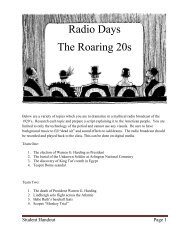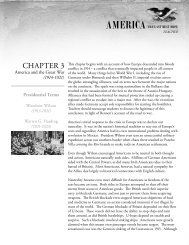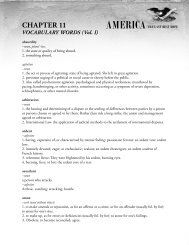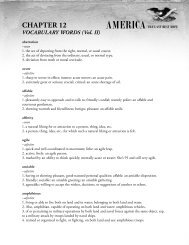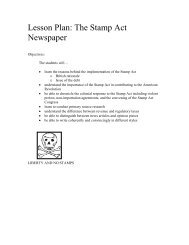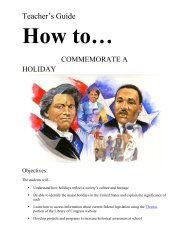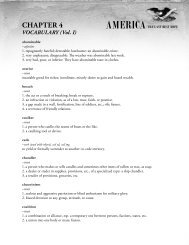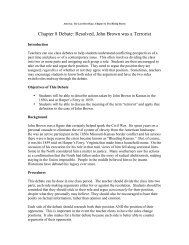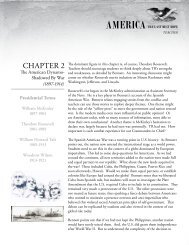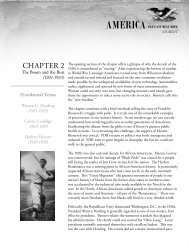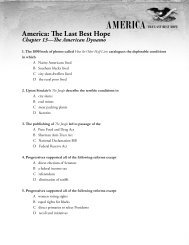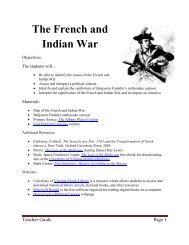Moderates vs. Radicals On the Nature of ... - Last Best Hope
Moderates vs. Radicals On the Nature of ... - Last Best Hope
Moderates vs. Radicals On the Nature of ... - Last Best Hope
Create successful ePaper yourself
Turn your PDF publications into a flip-book with our unique Google optimized e-Paper software.
America: The <strong>Last</strong> <strong>Best</strong> <strong>Hope</strong>, Volume I, Chapter 11, To Bind Up <strong>the</strong> Nation’s WoundsChapter 11 Debate: <strong>Moderates</strong> <strong>vs</strong>. <strong>Radicals</strong><strong>On</strong> <strong>the</strong> <strong>Nature</strong> <strong>of</strong> ReconstructionIntroductionTeachers can use class debates to help students understand conflicting perspectives <strong>of</strong> apast time and place or <strong>of</strong> a contemporary issue. This <strong>of</strong>ten involves dividing <strong>the</strong> classinto two or more parts and assigning each group a role. Students are <strong>the</strong>n encouraged totake on that role and argue <strong>the</strong>ir position. They need to argue <strong>the</strong> position <strong>the</strong>y areassigned, regardless <strong>of</strong> whe<strong>the</strong>r or not <strong>the</strong>y agree with that position. Sometimes, teachersmay encourage students to know both sides <strong>of</strong> <strong>the</strong> argument and have <strong>the</strong> two sidesswitch roles midway through <strong>the</strong> debate.Objectives <strong>of</strong> This Debate• Students will learn key arguments put forth by <strong>Radicals</strong> and <strong>Moderates</strong> in <strong>the</strong>debate over <strong>the</strong> nature <strong>of</strong> Reconstruction.• Students will evaluate which approach to Reconstruction would best unify <strong>the</strong>nation and would best protect <strong>the</strong> newly free slaves.BackgroundAs early as 1863, Republicans in <strong>the</strong> North began to debate <strong>the</strong> nature <strong>of</strong> what wouldbecome known as Reconstruction – <strong>the</strong> process whereby <strong>the</strong> Union would become oneagain. In his second inaugural address, Lincoln called upon all Americans to “bind up<strong>the</strong> nation’s wounds.” This would prove to be no easy task.It quickly became apparent that <strong>the</strong> nature <strong>of</strong> Reconstruction was a controversialquestion. <strong>On</strong> <strong>the</strong> moderate side was Lincoln himself. As he stated in that secondinaugural, he wanted <strong>the</strong> process to be carried out “with malice toward none, with charityfor all.” This meant a lenient, quick Reconstruction process. Lincoln believed harshermeasures would only elicit bitterness and make it impossible to bring unity. From aphilosophical perspective, Lincoln believed he, as president, had <strong>the</strong> constitutional rightto design and carry out Reconstruction. In his mind, <strong>the</strong> states <strong>of</strong> <strong>the</strong> South never actuallyseceded; <strong>the</strong>y only took part in a “domestic rebellion.” The Constitution gives <strong>the</strong>president <strong>the</strong> right to quell such a rebellion. Thus, he planned to pursue hisReconstruction program without <strong>the</strong> participation <strong>of</strong> Congress.The Radical Republicans, led by men like Senator Charles Sumner and RepresentativeThaddeus Stevens, had very different views. Philosophically, <strong>the</strong>y argued that <strong>the</strong> Southhad indeed seceded and had left <strong>the</strong> United States. Stevens called those rebellious states“conquered provinces.” Constitutionally, only Congress can admit new states, thus<strong>Radicals</strong> saw Reconstruction as totally under <strong>the</strong> control <strong>of</strong> <strong>the</strong> legislature. And beyond
this difference, <strong>Radicals</strong> believed deeply that <strong>the</strong> South and its leaders should be punishedfor <strong>the</strong>ir treasonous acts. Part <strong>of</strong> this was to insure justice. Also paramount was <strong>the</strong>desire <strong>of</strong> <strong>the</strong> <strong>Radicals</strong> to protect <strong>the</strong> new freedmen from being exploited by whiteSou<strong>the</strong>rners. Fur<strong>the</strong>r, <strong>Radicals</strong> hoped that if given civil rights, <strong>the</strong> freedmen wouldultimately vote Republican, thus creating a truly national Republican party that couldprotect and extend Republican policies (tariff, banking, railroads, Homestead Act) passedduring <strong>the</strong> war.In this historical debate, students should role-play citizens during <strong>the</strong> last years <strong>of</strong> <strong>the</strong>Civil War and examine <strong>the</strong> arguments on both sides <strong>of</strong> <strong>the</strong> crucial question – what shouldbe <strong>the</strong> nature <strong>of</strong> Reconstruction?ProceduresThis debate can be done in one class period. The teacher should divide <strong>the</strong> class into twoparts, each side making arguments for <strong>the</strong>ir assigned point <strong>of</strong> view. Students should bereminded that <strong>the</strong>y should stick to <strong>the</strong>ir role and argue passionately for <strong>the</strong>ir position,despite what <strong>the</strong>y personally may believe. They should also be encouraged to base <strong>the</strong>irpoints on factual information, ra<strong>the</strong>r than opinion and emotion.Each side <strong>of</strong> <strong>the</strong> debate should research both <strong>the</strong>ir position AND <strong>the</strong> position <strong>of</strong> <strong>the</strong>iropponents. This is important in <strong>the</strong> event <strong>the</strong> teacher elects to have <strong>the</strong> sides changepositions. It also makes for a better debate because each side is better able to counterarguments <strong>of</strong> <strong>the</strong>ir opponents.Students should be able to use America: The <strong>Last</strong> <strong>Best</strong> <strong>Hope</strong> to find dual perspectives on<strong>the</strong>se issues, but teachers will also need to provide background through short lectures orexplanations. Students can also do research on <strong>the</strong>ir own to find arguments to support<strong>the</strong>ir point <strong>of</strong> view. Primary sources from <strong>the</strong> period can be particularly valuable as aside builds its case.The following chart represents basic points that should be covered by both sides.Teachers should not immediately give students <strong>the</strong>se points. They might be <strong>of</strong>fered toeach side after students have had time to research on <strong>the</strong>ir own, or <strong>the</strong>y might be withhelduntil after <strong>the</strong> debate and used as a summary or to debrief <strong>the</strong> debate.A blank version <strong>of</strong> <strong>the</strong> chart is <strong>of</strong>fered at <strong>the</strong> end <strong>of</strong> this debate. Students may use thisblank chart to take notes as <strong>the</strong>y research <strong>the</strong>ir positions in <strong>the</strong> debate.When <strong>the</strong> debate takes place, arrange student desks or chairs with <strong>the</strong> two debate factionson opposite sides <strong>of</strong> <strong>the</strong> classroom facing each o<strong>the</strong>r. The teacher should serve as amoderator, beginning <strong>the</strong> proceedings, laying out <strong>the</strong> issues, and calling on members <strong>of</strong>each side in alternating order. If <strong>the</strong> debate begins to lag, <strong>the</strong> teacher may call a shortbreak and have each side “caucus” to rethink <strong>the</strong>ir positions and prepare responses toarguments made by <strong>the</strong> o<strong>the</strong>r side.
<strong>Moderates</strong> <strong>vs</strong>. <strong>Radicals</strong> <strong>On</strong> <strong>the</strong> <strong>Nature</strong> <strong>of</strong> Reconstruction<strong>Moderates</strong><strong>Radicals</strong>• We must follow President Lincoln’slead and have “malice toward noneand charity for all.”• Lincoln’s wisdom is critical – aharsh Reconstruction will only leadto bitterness – <strong>the</strong> nation wouldnever come toge<strong>the</strong>r under thosecircumstances.• The South is defeated and will belooking for new answers. Manypeople <strong>the</strong>re will likely be open tonew ways <strong>of</strong> thinking. All <strong>of</strong> ourpolicies will help <strong>the</strong>m rebuild.Many will very likely come to ourway <strong>of</strong> thinking on policies.• <strong>On</strong> <strong>the</strong> question <strong>of</strong> freedmen voting,we think that should be left to eachstate, just like it always has. Afterall, most nor<strong>the</strong>rn states don’t allowblack men to vote. Can we force<strong>the</strong> South to do so?• We can create a nationalRepublican party by working with<strong>the</strong> South in a generous way.Former Whigs, people open tobuilding a New South, andsou<strong>the</strong>rners who opposed secessionare all possible Republicans. Wedon’t need to build our party <strong>the</strong>reat <strong>the</strong> point <strong>of</strong> a sword.• Reconstruction is <strong>the</strong> role <strong>of</strong> <strong>the</strong>President and we should followLincoln. He is authorized by <strong>the</strong>Constitution to put down domesticrebellions.• We need to remember that <strong>the</strong>leaders <strong>of</strong> <strong>the</strong> South violated <strong>the</strong>iroaths to defend our Constitution.They are traitors guilty <strong>of</strong> treason.• If we are not harsh, <strong>the</strong> South willreturn <strong>the</strong> same secessionists toCongress – all Democrats. Thatwill threaten all <strong>of</strong> <strong>the</strong> policies wehave worked so hard to pass –tariff, banking, Homestead,railroads.• Without harsh and strictReconstruction, do you thinksou<strong>the</strong>rners will give rights to <strong>the</strong>freedmen? We need to require that<strong>the</strong>y allow <strong>the</strong> freed slaves to vote.• Remember also, that <strong>the</strong> freedmen,if allowed to vote, will voteRepublican; thus we make our partya national party!• It is naïve to think <strong>the</strong> states <strong>of</strong> <strong>the</strong>South will treat freedmen withjustice. Leaders <strong>the</strong>re will doanything to keep <strong>the</strong> freedmen in aslave-like state. We need tostrongly push to insure that <strong>the</strong>ircivil rights are guaranteed.• This war was FAR more than a“domestic rebellion.” The states <strong>of</strong><strong>the</strong> South seceded and left ournation. They thus are conqueredprovinces with NO rights. By <strong>the</strong>Constitution, Congress admits newstates. Congress shall runReconstruction, not <strong>the</strong> President.
America: The <strong>Last</strong> <strong>Best</strong> <strong>Hope</strong>, Volume I, Chapter 11, To Bind Up <strong>the</strong> Nation’s WoundsStudent Debate SheetName___________________Date____________________As your group researches <strong>the</strong>ir position on <strong>the</strong>se issues, use <strong>the</strong> following table to recordyour views and prepare for <strong>the</strong> debate. You should research and prepare for both sides <strong>of</strong>this debate. As <strong>the</strong> debate progresses, make notes made by <strong>the</strong> opposing side that yourside did not anticipate.<strong>Moderates</strong> <strong>vs</strong>. <strong>Radicals</strong> <strong>On</strong> <strong>the</strong> <strong>Nature</strong> <strong>of</strong> Reconstruction<strong>Moderates</strong><strong>Radicals</strong>



